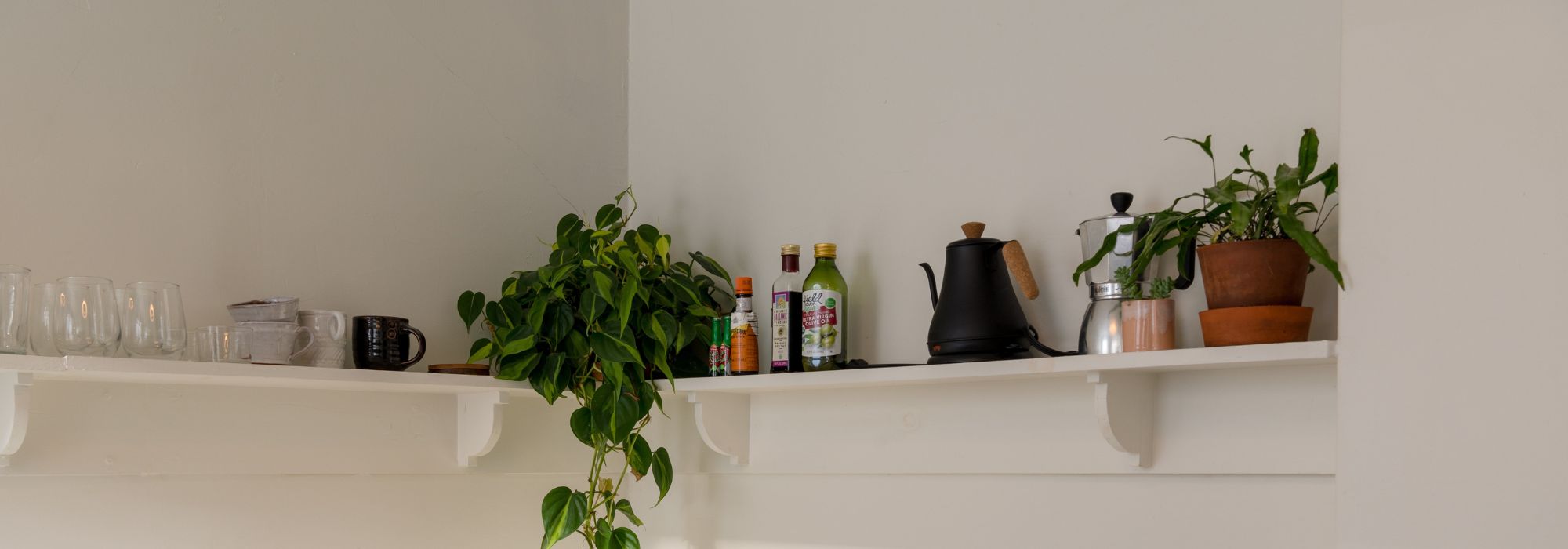
Indoor plants for the kitchen: our ideal varieties and tips for decorating this space
Everything you need to know to beautify your kitchen with plants
Contents
The kitchen is often the heart of the home: a lively, warm place where good meals, conversations, and culinary creativity are shared. And what better way to enhance this friendly atmosphere than with a bit of greenery? Indoor plants are not limited to the living room or bedroom, they also have their place in the kitchen, where they can bring freshness, charm, and a lovely touch of nature.
But be careful, not all plants are suited to live in a kitchen. C’est a unique space, with its specific constraints: temperature variations, humidity, uneven light… This requires some thought to choose the right companion plants.
In this article, discover how to install indoor plants that perfectly integrate into your kitchen, without compromising either space or practicality.
The specific constraints of cooking
Before choosing the perfect plants for this space, it is essential to understand that the kitchen has specific conditions that distinguish it from the rest of the house. A plant that thrives in a living room may not necessarily flourish near the sink or cooking hobs. Here are the main constraints to consider:
Light
The kitchen can be very bright with large windows… or conversely quite dark if it faces an internal courtyard or is north-facing. Some plants require bright light, while others are content with indirect or subdued lighting. The idea is to choose based on the actual exposure of your room: direct light? filtered? low?
Humidity
With cooking steam, kettles, and sinks, humidity in a kitchen can fluctuate quite significantly. This can be an advantage for tropical plants that enjoy humidity, but a disadvantage for those that prefer drier air. Care should also be taken with condensation, especially if the kitchen is poorly ventilated.
Heat
The kitchen can become very hot, especially around the hobs or oven. These temperature spikes can stress certain plants, particularly if they are placed too close to heat sources. It is therefore advisable to maintain a certain distance between the plants and the cooking appliances.
Available Space
Kitchens are often cluttered: worktops, appliances, crockery… It’s not always easy to fit in pots! Fortunately, there are plenty of tricks to incorporate plants even in a small space: hanging plants, magnetic pots, mini planters on window sills… The important thing is to think vertically and about mobility.
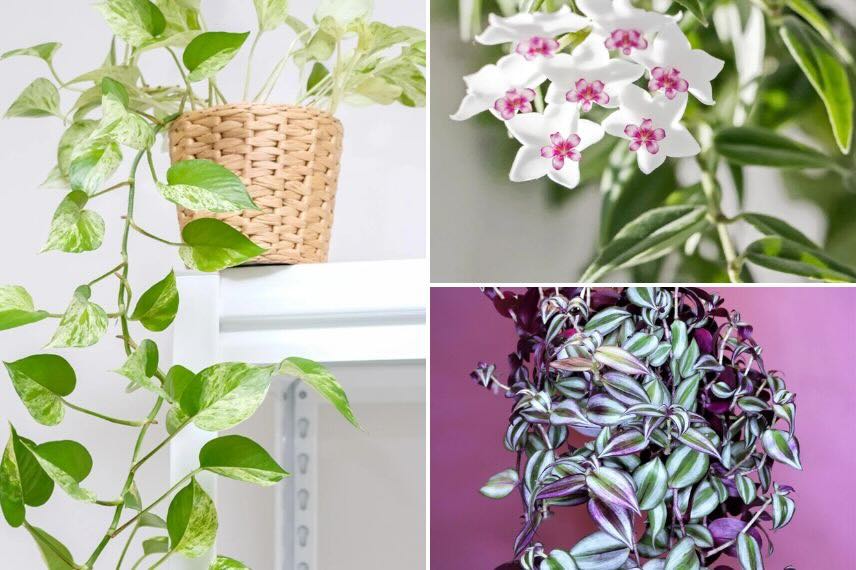
Hanging trailing plants is an ideal option in the kitchen: Pothos on the left, Hoya bella flower and Tradescantia zebrina
Plants suitable for the kitchen
There are many varieties of houseplants that not only thrive in kitchen conditions but also add real charm to the space. Here are some suggestions classified by type of location or need.
Hanging plants: to save space in style
Perfect above the sink, on a high shelf, or suspended from the ceiling, these plants bring a touch of airy greenery to the kitchen:
- Pothos (Epipremnum aureum): one of the least demanding and most resilient houseplants. Pothos grows quickly, tolerates medium light and occasional neglect in watering, as well as high humidity, and its long trailing stems adorned with heart-shaped leaves are very decorative.
- Hoya bella: Hoyas can be a bit tricky to grow as they require specific growing conditions. However, the species Hoya bella stands out for its simplicity and resilience, as well as its tendency to bloom generously. It enjoys good light and handles temperature variations well. Its porcelain flowers are small, delightfully fragrant jewels.
- Tradescantia zebrina: a lovely plant with trailing foliage, featuring colourful, silver and purple leaves. It grows quite quickly, appreciates regular watering, and is fairly tolerant of light conditions.
Small windowsill plants
When you have a small surface, you can opt for compact plants, but avoid direct sunlight:
- Peperomia: there are many colourful varieties (with round, ribbed, variegated leaves…), they handle medium light well and remain compact.
- Syngonium : some are trailing, but others form compact plants that can be placed on surfaces, with beautiful often variegated foliage in white, green, or pink.
- Pilea glaucophylla ‘Greyzy’: this small plant with tiny round leaves is easy to care for and takes up little space.
Plants for darker corners
Not all kitchens are bathed in light, and some plants adapt very well to low light conditions:
- Zamioculcas zamiifolia : very resilient, this sturdy plant grows even in low light and requires little watering.
- Chlorophytum: comfortable in all conditions, Chlorophytum forms a rounded tuft with elongated leaves.
- Aglaonema: very decorative with its colourful leaves, it is also robust and perfect for low-light spaces.
Plants that love humidity
If your kitchen is a bit like a mini-greenhouse after every meal, these plants will love it (they are also suitable for darker spaces):
- Ferns: they love warmth and ambient humidity. Perfect for hanging or placing on a table or high up.
- Calathea: it offers magnificent foliage and enjoys a humid atmosphere. Perfect if you have a fairly large kitchen and filtered light.
- Maranta: also known as the “prayer plant”, its leaves move with the light. It loves humidity and soft light.
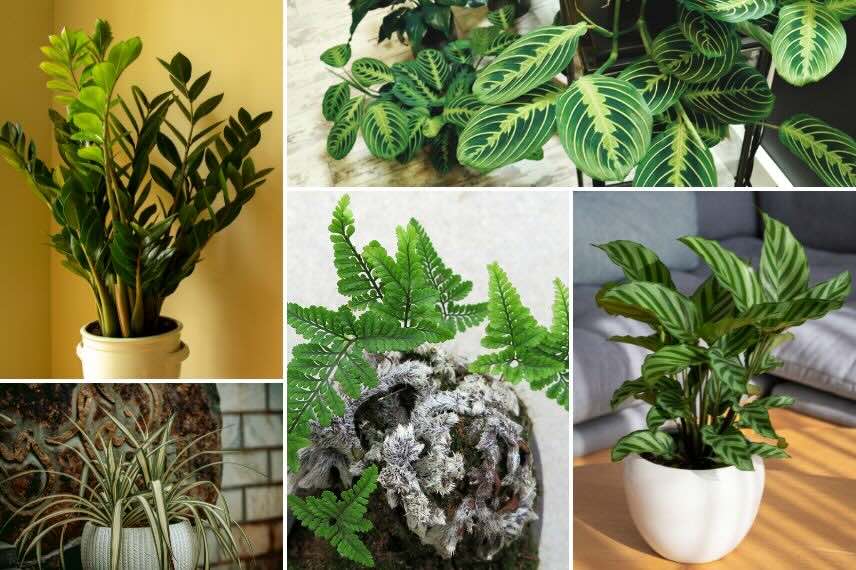
Plants for a low-light kitchen clockwise: Zamioculcas zamiifolia, Maranta, Calathea, Rabbit’s Foot Fern, Chlorophytum
How to effectively integrate plants into your kitchen decor
Having plants in the kitchen is great… but you still need to find a place for them without encroaching on preparation or storage space. Fortunately, there are plenty of decor tips to ensure your plants fit perfectly into this environment without becoming overwhelming. They bring a real touch of life and style!
Utilise heights
When floor or worktop space is limited, think vertically:
- Hanging plants from the ceiling or on a curtain rod above a window.
- Wall shelves with one or two plants mixed with decorative objects or utensils.
- Suctions or hook supports to hang small pots on tiles, the fridge, or a splashback.
Opt for suitable containers
Pots play a key role in the overall look. Here are some ideas to make them stylish and functional:
- Ceramic pots for a chic and sleek look.
- Glass jars or recycled small tin cans for a trendy upcycled spirit.
- Hanging baskets or macramé for a bohemian touch.
- Magnetic pots to attach to the fridge or a metallic surface (super practical and space-saving!).
Create little “jungle” corners
You can also group several plants, even in a small kitchen:
- On a sunny windowsill with different heights of pots.
- In an unused corner with a small side table or a low unit.
- On an open shelf with cookbooks or jars.
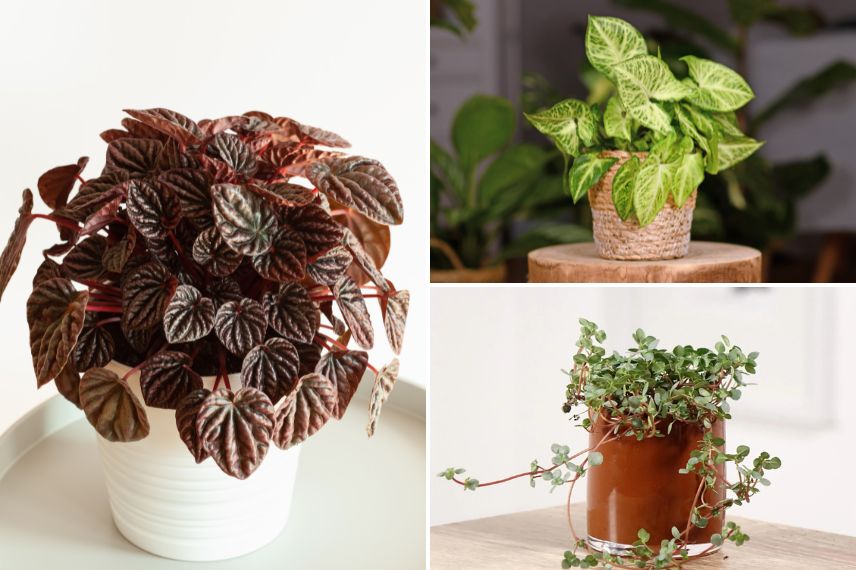
Combine several pots of compact plants on a windowsill, for example: Peperomia with coppery leaves, variegated Syngonium, and Pilea ‘Greysy’
Specific kitchen care tips
Even if you choose easy-going plants, the kitchen remains a somewhat unique environment. Between the heat, splashes, and changes in humidity, there are a few good habits to adopt to keep your plants happy and healthy.
Manage watering well
The temperature and humidity in the kitchen can be misleading: the substrate may appear dry on the surface but still be moist deeper down.
- Check the moisture of the potting soil with your finger before watering.
- Opt for pots with drainage holes to prevent water from stagnating.
- Be cautious of limescale in tap water; some plants (like calatheas) do not tolerate it well and prefer filtered water.
Regularly clean the leaves
In a kitchen, leaves can quickly become a bit greasy or dusty due to cooking vapours.
- Wipe the leaves with a damp cloth from time to time.
- For plants with fine foliage (like ferns), a light misting can do the trick.
Monitor exposure and rotate pots
Light can change throughout the seasons or depending on the time of day.
- Rotate the pots a quarter turn every two weeks for even growth.
- Observe if the leaves lean towards the light or become pale: this is often a sign that they need to be moved.
Keep an eye on heat
Some plants do not like being close to an oven or under a hood. Direct heat can scorch their leaves or dry them out.
- Avoid the edges of the stove or the ledges just above the dishwasher.
- Place plants at least 30 cm away from intense heat sources.
Beware of pests
A kitchen can sometimes attract insects, and some plants may become an entry point.
- Avoid leaving stagnant water in saucers.
- Occasionally inspect the leaves (top and bottom) for signs of mealybugs or aphids.
- Subscribe!
- Contents
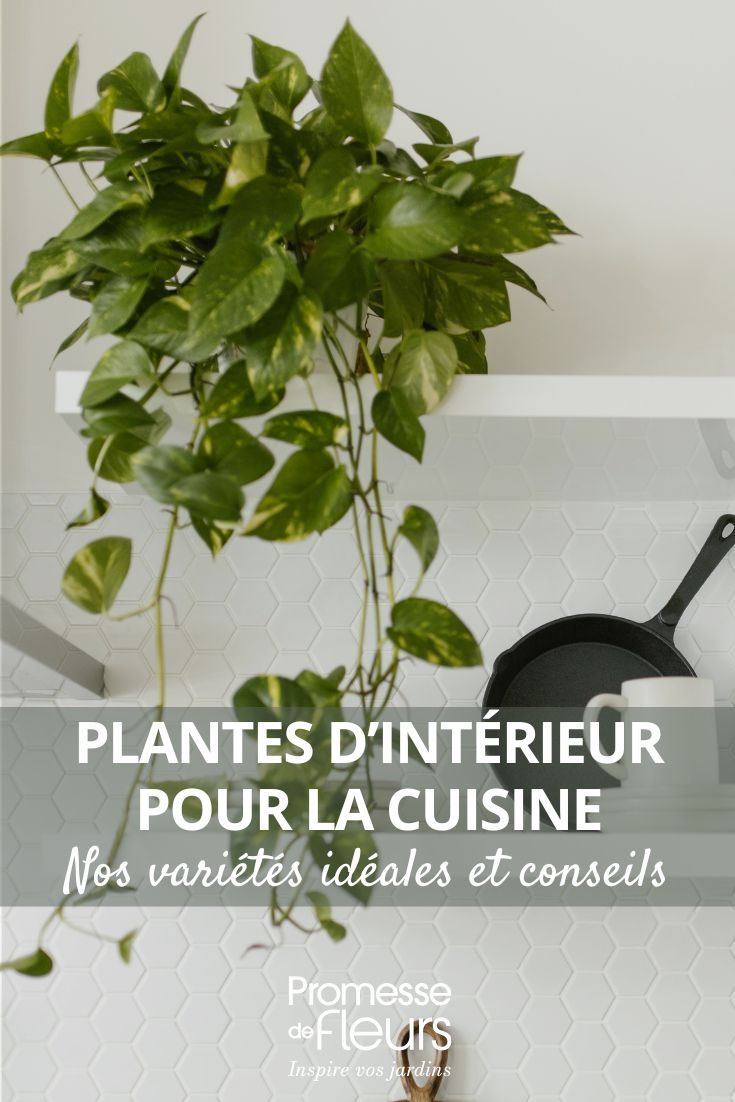































Comments